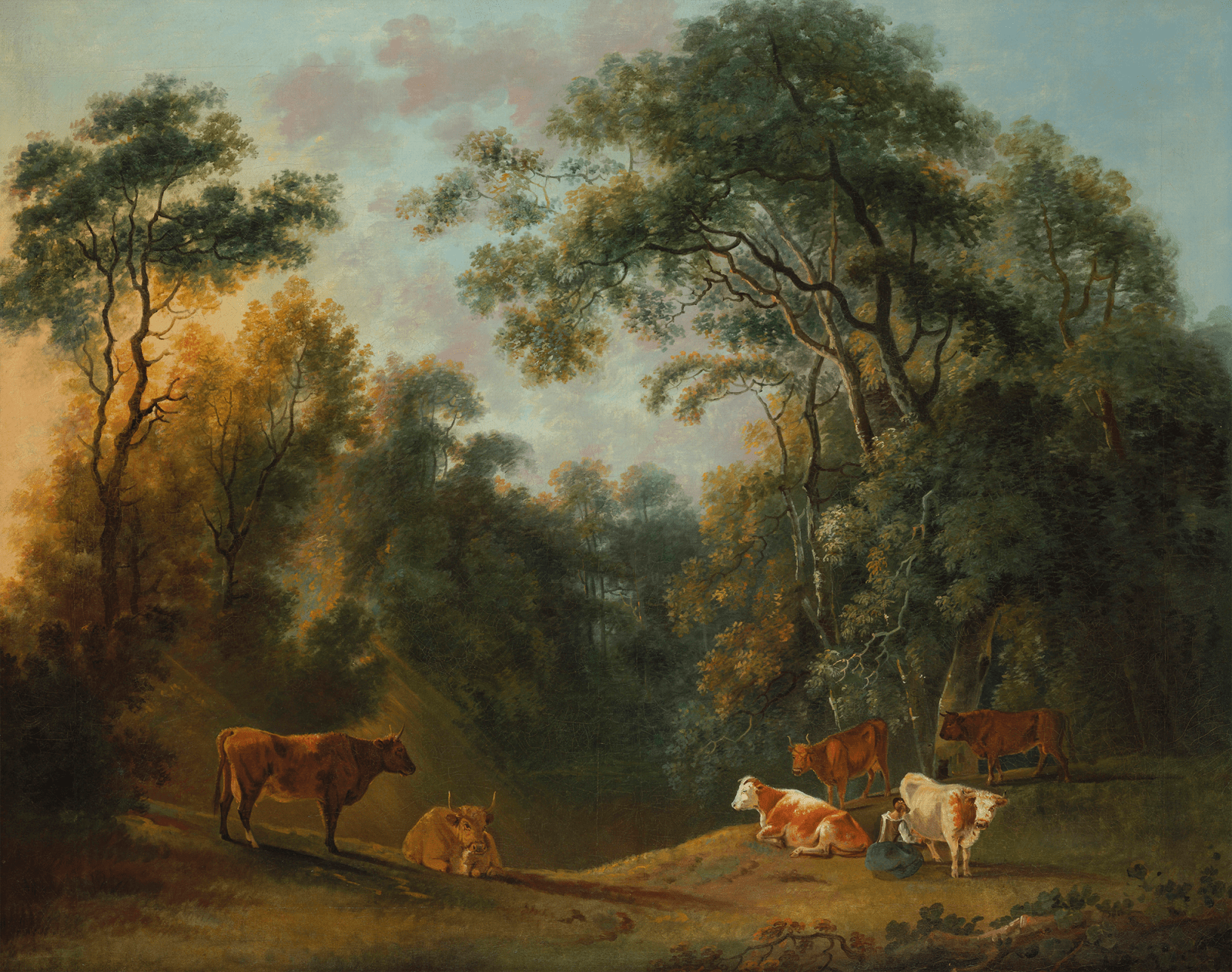
George Barret Sr. RA
A Wooded Landscape with a Milkmaid and Cattle
Oil on canvas
38 9/16 x 48 1/16in, 98 x 122cm
Philip Mould & Co.
To view all current artworks for sale visit philipmould.com The style of landscape painting most frequently associated with the eighteenth century is of course Romanticism, pioneered by the likes...
To view all current artworks for sale visit philipmould.com
The style of landscape painting most frequently associated with the eighteenth century is of course Romanticism, pioneered by the likes of Constable, although seldom remembered are the great artists who worked just prior to the industrial age and whose work echoes a different, yet equally fascinating, response to their surrounding countryside.
In Barret’s early years, with the exception of some brief training at Benjamin West’s Academy in Dublin in 1747, he remained largely self-taught and relied on seventeenth century models of Dutch and Italian landscape painting for influence. Learning, and to some degree imitating, the great Dutch landscape painters was a beaten track followed by many young artists of that period – we know for example that the early works of Thomas Gainsborough (1727-1788) even to this day can sometimes be wrongly attributed to the Dutch painter Jacob van Ruisdael (1628-1682). Barret’s works painted in the immediate years following his departure from Ireland show a distinct emergence of a unique style leading fellow painter James Barry, when writing to his patron Edmund Burke in c.1765, to say;
“Barret presents you with such a glorious assemblage, as I have sometimes seen among high mountains rising into unusual agreeable appearances while the early beams of the sun sports themselves…through the vast arcades and sometimes glances on a great lake whose ascending vapours spread themselves like a veil over the distance”. (1)
Much in common with great contemporaries such as Constable, Barret added a great degree of characterisation in his depictions of the English countryside and was widely noted for his acuteness of botanical details, praised by Burke as ‘a wonderful observer of the accidents of nature’. (2) As seen in the present work, Barret was clearly fascinated by the light of the English countryside, focussing on a single light source which permeates through the trees to the left of the riverbank.
It seems that Barret was just as accomplished in his depiction of animals as he was with his drawing of nature, which is quite puzzling as it is known that he often worked in collaboration with the animal painter Sawry Gilpin (1733-1807), an alliance exemplified in the present work.
(1)The Works of James Barry, ed. E. Fryer, vol.1, p.g 16.
(2)The Works of James Barry, ed. E. Fryer, vol.1, p.g 89.
The style of landscape painting most frequently associated with the eighteenth century is of course Romanticism, pioneered by the likes of Constable, although seldom remembered are the great artists who worked just prior to the industrial age and whose work echoes a different, yet equally fascinating, response to their surrounding countryside.
In Barret’s early years, with the exception of some brief training at Benjamin West’s Academy in Dublin in 1747, he remained largely self-taught and relied on seventeenth century models of Dutch and Italian landscape painting for influence. Learning, and to some degree imitating, the great Dutch landscape painters was a beaten track followed by many young artists of that period – we know for example that the early works of Thomas Gainsborough (1727-1788) even to this day can sometimes be wrongly attributed to the Dutch painter Jacob van Ruisdael (1628-1682). Barret’s works painted in the immediate years following his departure from Ireland show a distinct emergence of a unique style leading fellow painter James Barry, when writing to his patron Edmund Burke in c.1765, to say;
“Barret presents you with such a glorious assemblage, as I have sometimes seen among high mountains rising into unusual agreeable appearances while the early beams of the sun sports themselves…through the vast arcades and sometimes glances on a great lake whose ascending vapours spread themselves like a veil over the distance”. (1)
Much in common with great contemporaries such as Constable, Barret added a great degree of characterisation in his depictions of the English countryside and was widely noted for his acuteness of botanical details, praised by Burke as ‘a wonderful observer of the accidents of nature’. (2) As seen in the present work, Barret was clearly fascinated by the light of the English countryside, focussing on a single light source which permeates through the trees to the left of the riverbank.
It seems that Barret was just as accomplished in his depiction of animals as he was with his drawing of nature, which is quite puzzling as it is known that he often worked in collaboration with the animal painter Sawry Gilpin (1733-1807), an alliance exemplified in the present work.
(1)The Works of James Barry, ed. E. Fryer, vol.1, p.g 16.
(2)The Works of James Barry, ed. E. Fryer, vol.1, p.g 89.
Provenance
Anthony Dallas & Sons, London, June/July 1983 Private Collection.Be the first to hear about our available artworks
* denotes required fields
We will process the personal data you have supplied in accordance with our privacy policy (available on request). You can unsubscribe or change your preferences at any time by clicking the link in our emails.